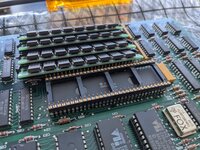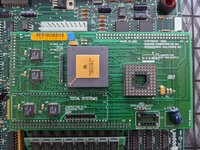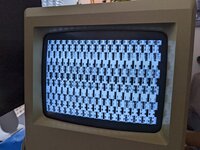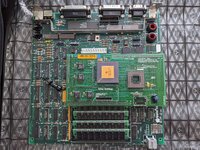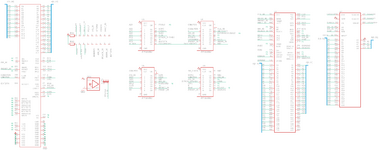I have a Plus with a Total Systems '030 accelerator that's giving me some problems, I'm hoping someone here might be able to help. I've had the board for years, it sat for a very long time without being used, and a couple years ago when I tried to remove it from the machine, the plastic Killy Clip broke in multiple places and was no longer usable. Recently I had someone solder pin headers onto the 68000 so the accelerator would sit on the CPU without the Killy Clip. It worked at first, though the tall 1mb SIMMs stopped the board from seating on the pin headers completely.
Fast forward a couple of uses (the machine doesn't see much use), I had the accelerator out for some reason, re-installed it and powered on, and the machine wouldn't boot, there was no beep. I re-seated the accelerator and tried again and the machine booted fine. I had already ordered some low-profile SIMMs to allow the accelerator to seat fully, so I set the machine aside until those arrived, assuming everything was fine since the machine had just successfully booted with the accelerator. The low-profile SIMMs showed up, I installed them, installed the accelerator, powered on, and no chime. The screen was mostly black with a few white pixels.
I went through a few different combinations, and the end result is this:
- The machine boots and works fine without the accelerator, with either my 4 original 1mb "tall" SIMMs, or the 4 1mb "low profile" SIMMs
- With the accelerator installed, the machine won't boot, regardless of which set of SIMMs I use.
I have re-seated the accelerator numerous times, I have cleaned the socket and pin headers with DeoxIT, and I have checked continuity between the CPU and the tips of the header pins, just in case there was a broken solder joint somehow. The only connection from the accelerator to the logic board is the CPU socket and the clock signal clip. I have confirmed the clip is on the correct pin, and have also cleaned the clip with DeoxIT.
I've attached a couple pics of the screen during the non-boot state. Ever since the accelerator was in its known-working state, I have never handled it without a wrist ground strap, and it has always been stored in an ESD bag when not in use. I'm hoping it hasn't been damaged somehow.
Edit: added a photo showing the location of the clock signal clip. It's difficult to see, but it is clipped onto the end pin of the IC, not the second pin. The clip has an insulated plastic piece that ensures it does not contact the second pin.
Fast forward a couple of uses (the machine doesn't see much use), I had the accelerator out for some reason, re-installed it and powered on, and the machine wouldn't boot, there was no beep. I re-seated the accelerator and tried again and the machine booted fine. I had already ordered some low-profile SIMMs to allow the accelerator to seat fully, so I set the machine aside until those arrived, assuming everything was fine since the machine had just successfully booted with the accelerator. The low-profile SIMMs showed up, I installed them, installed the accelerator, powered on, and no chime. The screen was mostly black with a few white pixels.
I went through a few different combinations, and the end result is this:
- The machine boots and works fine without the accelerator, with either my 4 original 1mb "tall" SIMMs, or the 4 1mb "low profile" SIMMs
- With the accelerator installed, the machine won't boot, regardless of which set of SIMMs I use.
I have re-seated the accelerator numerous times, I have cleaned the socket and pin headers with DeoxIT, and I have checked continuity between the CPU and the tips of the header pins, just in case there was a broken solder joint somehow. The only connection from the accelerator to the logic board is the CPU socket and the clock signal clip. I have confirmed the clip is on the correct pin, and have also cleaned the clip with DeoxIT.
I've attached a couple pics of the screen during the non-boot state. Ever since the accelerator was in its known-working state, I have never handled it without a wrist ground strap, and it has always been stored in an ESD bag when not in use. I'm hoping it hasn't been damaged somehow.
Edit: added a photo showing the location of the clock signal clip. It's difficult to see, but it is clipped onto the end pin of the IC, not the second pin. The clip has an insulated plastic piece that ensures it does not contact the second pin.

